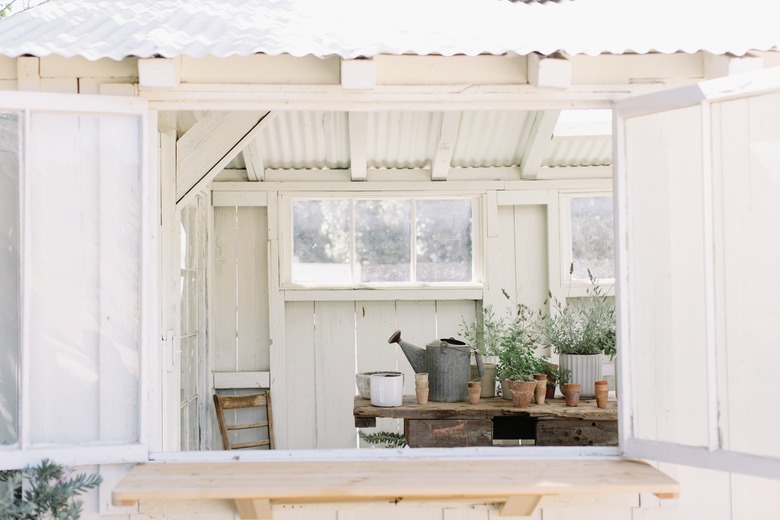7 Eco-Friendly Things To Do For Your Garden
Think of spring as the earth's birthday, a time of new beginnings. What's one way to celebrate? By making eco-friendly updates to your garden. You don't have to make dramatic gestures, just a few tweaks and tricks can make an impact. Here are some helpful things to put on your to-do list — one for every day of the week.
1. Plant a tree.
1. Plant a tree.
No better way to invest in the future of the planet — and improve the looks of your garden — than by planting a tree. April is the month of both Arbor Day and Earth Day, and spring is an excellent time for tree transplants.
- How does it help the earth? Global warming results from a buildup of greenhouse gases like carbon dioxide and methane that trap heat on the planet. Trees remove CO2 from the air, and produce life-sustaining oxygen.
- How does it help the garden? Trees are the bones of a garden, stabilizing soil, providing shade, and attracting birds. Fruit trees also feed wildlife and humans while flowering trees attract bees and beneficial insects.
2. Start a vegetable garden.
2. Start a vegetable garden.
One factor that makes us forget our close relationship with Mother Nature is that most of the food we eat comes from a supermarket. Growing your own veggies helps you reconnect with nature in a way that brings immediate rewards: you put in the work, you get the produce.
- How does it help the earth? Taking some of the growing business away from big agriculture and assuming responsibility for it means more individual responsibility for the environment.
- How does it help the garden? A garden that has both flowers and vegetables attracts a wider variety of beneficial bugs and pollinators over ornamental plants alone.
3. Banish bee-killing sprays.
3. Banish bee-killing sprays.
The world we know it would not exist without bees, our number one pollinators. Not everyone has the expertise or space to install hives in the backyard, but you can still help the bee population by eliminating any sprays that have bee-lethal neonicotinoid (neonic) pesticides.
- How does it help the earth? Bees pollinate agricultural plants and those in the wild. If bees are eliminated, so are many plant species and the seeds, fruit, and nuts that they produce.
- How does it help the garden? Bees are terrific pollinators for your own flowers and veggies and help to make your backyard plants thrive.
4. Start a compost pile.
4. Start a compost pile.
In nature, leaves, flowers, and fruits fall to the earth and decompose, enriching the soil naturally with nutrients and encouraging microorganisms that aerate the soil. You can buy a pre-made substitute compost at a garden store but you'll get better produce if you recycle your own vegetable peels, fruit cores, coffee grounds, egg shells, and yard clippings. Creating a compost area can be as easy as picking a corner in which to heap these materials to allow them to decompose.
- How does it help the earth? Compost acts as a wonderful and entirely safe alternative to chemicals used to kill weeds and as fertilizers.
-
How does it help your garden?
Composting introduces beneficial organisms that help aerate, feed, and hold moisture in the soil. Layered around plants, it regulates the soil temperature, improves the soil quality, and keeps down weeds naturally.
5. Install a bird feeder.
5. Install a bird feeder.
Birds are not just a delight in your backyard, with their soft chirps and bright feathers, they are also extremely effective at limiting the population of snails, slugs, caterpillars, grubs, and other insect pests. Putting in bird feeders and watering areas costs very little. You can also plant flowers to attract them.
- How does it help the earth? The planet is healthier if gardeners rely on birds instead of toxic synthetic insecticides, fungicides, and weed killers.
- How does it help your garden? Your backyard will have less insect pests that destroy your foliage and crops, plus the soft note of birdsong.
6. Feed the hummingbirds.
6. Feed the hummingbirds.
Bright, jewel-toned darters, hummingbirds are lovely additions to a garden, but they are also fabulous pollinators. You can take the traditional route and put up feeders. But you can do even more for the planet by seeding in native plants with tube-shaped flowers like sages (Salvia spp.).
- How does it help the earth? The more pollinators, the more diverse plant species in an area. And diversity helps feed and nurture insect and animal populations.
- How does it help your garden? What garden doesn't look happier with hummers flitting about? And sage is a low-maintenance plant with gorgeous, bright blossoms.
7. Introduce native plants.
7. Introduce native plants.
Native plants lived in your area before you did and have already adapted to the climate and ecosystem. Using them in your garden fosters a healthy environment since they grow without fertilizers or pesticides. They are low-to-no maintenance, too.
- How does it help the earth? Gardeners often need to use chemicals when they try to make exotic plants thrive in places nature didn't put them. Natives grow well without any help.
- How does it help your garden? Native wildflowers come in vast arrays of colors and sizes and bring native pollinators and beneficial bugs into your backyard.
References
- Old Farmer's Almanac: 10 Tips for an Eco-Friendly, Low Maintenance Garden
- Old Farmer's Almanac: Reusing Plants Pots and Containers
- KCET: 10 Eco-Friendly Things You Can Do for Earth Day (and Every Day!)
- National Resources Defense Council: Neonicotinoid Pesticides: Bad for Bees, and Maybe Bad for People, Too
